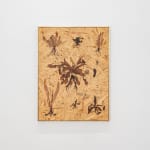Julius von Bismarck
On Sprinting Botany, 2024
Compressed wood strands, taxidermied animals, plants, textiles and brass frame
111 x 84 x 4 cm
43 3/4 x 33 1/8 x 1 5/8 inches
43 3/4 x 33 1/8 x 1 5/8 inches
Copyright The Artist
Photo: Dirk Tacke
Weitere Abbildungen
In der Werkserie „OOOSB“ verdichtet Julius von Bismarck verschiedene Realitätsebenen, indem er Pflanzen, Tiere und Objekte in eine Masse aus Holzspänen presst. Der physische Akt des Pressens nivelliert die Volumen...
In der Werkserie „OOOSB“ verdichtet Julius von Bismarck verschiedene Realitätsebenen, indem er Pflanzen, Tiere und Objekte in eine Masse aus Holzspänen presst. Der physische Akt des Pressens nivelliert die Volumen der einzelnen Elemente und hebt zugleich ihre Präsenz auf der Fläche hervor: als sichtbare Spuren, sedimentierte Formen, eingefrorene Relikte. So entstehen großformatige Bildkörper, in denen organische und kulturell geprägte Formen eng miteinander verwoben sind. Sie erinnern an die Tradition der Herbarien, in denen Pflanzen und Tiere gesammelt und katalogisiert werden, um die Natur zu erfassen und dem Menschen ein geordnetes Bild seiner Umwelt zu vermitteln. „OOOSB“ spiegelt den menschlichen Drang wider, Natur zu definieren, zu klassifizieren und zu kontrollieren. Der doppeldeutige Titel verweist sowohl auf das industrielle Pressspanplatten Oriented Strand Board (OSB) als auch auf die theoretische Strömung der Object-Oriented Ontology (OOO). Diese Philosophie stellt die menschliche Wahrnehmung infrage und spricht allen Dingen – unabhängig von ihrer Lebendigkeit, Nützlichkeit oder Zugänglichkeit – eine eigene Existenz zu, die nur teilweise wahrnehmbar ist. In diesem Spannungsfeld operieren von Bismarcks Werke: Das, was eingeschrieben ist, bleibt nicht bloß Darstellung, sondern tritt als gleichwertiges Objekt unter Objekten auf – mit eigener Geschichte und Bedeutung. Im Gegensatz zu den zufällig verstreuten Holzspänen von OSB-Platten sind die Späne in „OOOSB“ präzise angeordnet, was Kompositionen mit klarer Tiefenwirkung und Perspektiven erschafft. Die Werke stellen somit nicht nur eine Auseinandersetzung mit der Natur und ihrer Kategorisierung dar, sondern auch mit der Frage nach der Wahrnehmung und Existenz von Objekten.
In the work series “OOOSB”, Julius von Bismarck condenses various layers of reality by compressing plants, animals and objects into a mass of wood strands. The physical act of pressing levels out the volume of the individual elements while simultaneously emphasizing their presence on the surface: as visible traces, sedimented forms and frozen relics. This process produces large-format image-objects in which organic forms and culturally shaped forms are closely interwoven.
They recall the tradition of herbaria, where plants and animals are collected and catalogued for the sake of comprehending nature and to provide us with an ordered image of our environment. “OOOSB” reflects humanity’s urge to define, classify, and control nature. The ambiguous title references both the industrial composite material Oriented Strand Board (OSB) and the theoretical school of Object-Oriented Ontology (OOO). The latter challenges human-centered perception and ascribes an autonomous existence to all things—regardless of their vitality, usefulness, or accessibility—an existence that remains only partially perceptible.
Von Bismarck’s works operate within this field of tension: what is inscribed is not merely representational but emerges as an object among objects—with its own history and significance. Unlike the randomly scattered chips in OSB panels, the shavings in “OOOSB” are precisely arranged, creating compositions with clear depth and perspective. These works thus engage not only with nature and its categorization but also with fundamental questions of perception and the existence of objects.
In the work series “OOOSB”, Julius von Bismarck condenses various layers of reality by compressing plants, animals and objects into a mass of wood strands. The physical act of pressing levels out the volume of the individual elements while simultaneously emphasizing their presence on the surface: as visible traces, sedimented forms and frozen relics. This process produces large-format image-objects in which organic forms and culturally shaped forms are closely interwoven.
They recall the tradition of herbaria, where plants and animals are collected and catalogued for the sake of comprehending nature and to provide us with an ordered image of our environment. “OOOSB” reflects humanity’s urge to define, classify, and control nature. The ambiguous title references both the industrial composite material Oriented Strand Board (OSB) and the theoretical school of Object-Oriented Ontology (OOO). The latter challenges human-centered perception and ascribes an autonomous existence to all things—regardless of their vitality, usefulness, or accessibility—an existence that remains only partially perceptible.
Von Bismarck’s works operate within this field of tension: what is inscribed is not merely representational but emerges as an object among objects—with its own history and significance. Unlike the randomly scattered chips in OSB panels, the shavings in “OOOSB” are precisely arranged, creating compositions with clear depth and perspective. These works thus engage not only with nature and its categorization but also with fundamental questions of perception and the existence of objects.
1
von
4









